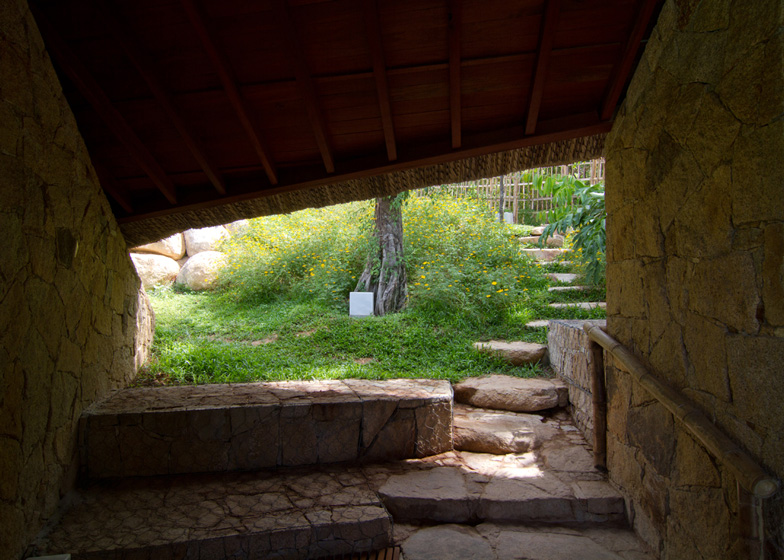Nine stone cabins are sheltered beneath a single thatched roof in this addition to a hotel resort in Nha Trang, Vietnam, by architecture practice a21studio (+ slideshow).
The buildings nestle into the rugged landscape of the I-Resort, forming an uneven row that wraps around a pair of staggered outdoor swimming pools and also includes a small bar and restaurant.
The architects at a21studio used indigenous techniques to construct the cabins, helped by a team of local masons and carpenters. Walls are built from locally quarried stone, while the roofing is made from timber and coconut leaves.
"The wooden roofs are constructed in a traditional way with mortise and tenon joint techniques," explain the architects. "These joints are easy to assemble and the connections are very strong, neat and hard to wobble."
The layout of each cabin is the same; a living room occupies one side of the space, while a toilet and washroom are tucked away at the back and a small paddling pool sits at the front.
Patterned tiles add a mixture of colours to the interior walls and floors. Windows are circular and entrances are positioned along the sides.
The bar and restaurant also shelters beneath the thatched roof and is positioned at the centre of the plan. This space is filled with reclaimed furniture and features a wall covered in old doors.
Other thatched cabins we've featured recently include reconstructed residences on an island in Indonesia and a bamboo bar in Vietnam's Binh Duong Province.
See more thatched buildings »
See more architecture in Vietnam »
Photography is by Hiroyuki Oki.
Here's some more information from a21studio:
9 Spa
9 spa is a set of nine hotel houses with spas, mud and mineral baths together with a small bar and restaurant, located in the centre of the group. The buildings are perched in the folds of halfway terrace up to a rock mountain and looking down to the service area, which has run business from two years ago. On this side, the project is received a lot of rain but lacked of wind from the river.
Using indigenous building techniques and materials, and adopting local custom as the key to managing the project, both architecturally and otherwise, 80 village masons, carpenters and craft persons were enlisted to build the hotel in a period of 9 months. The project was designed as a combination of dry-stacked stone with wood structure, quarried right on the site. All other materials such as coconut leaves and used furniture are used on the same manner.
The houses are set up in different specific angles and placed separately by a distance to let rain water go down easily from the top of mountain. The spaces between the blocks make an entrance lobby for each house. Moreover, it helps to increase ventilation for the whole area. The wooden roofs are constructed in a traditional way with mortise and tenon joint techniques. These joints are easy to assemble and the connections are very strong, neat, and hard to be wobbled. Unlike old buildings, in which these techniques are adopted popular, 9 spa is structured with lighter and lissom looks. Above this wooden structure, the roof is divided into 3 layers, including 20 mm thick wood panels, which gives an aesthetic look to ceiling and links all beams together, water proof and 30 mm coconut leaves, respectively. Besides, the project also makes use of old furniture from nearby buildings such as doors, tables and chairs or patterned tiles, give the buildings a distinctive look, the beauty or serenity of old items that comes with age.
The bar, with less than a dozen seats and the wooden floor, faced out to a garden looking to public resort, which makes the hotel hideaway from eventful area downhill. The level of restaurant floor was above from the ground, thereby linking the outside space to the interior and offering a new viewpoint to the customers, while not touching to existing nature. On the other words, by any means necessary, nature is treated as the core value to the whole building, that its beauty can be contemplated at every corner of the project. That could be a row of mountain far away through a rounded window or a garden view is enframed as a picture by unusual opens.
In conclusion, a group of nine hotel houses are linked by a continuous wooden roof, reflecting its surrounding environment and landscape. By using local materials as rock and wood together with adopting old furniture, 9 spa gives an extraordinary value to the existing project.
Client: I-resort
Location: Nha Trang, Vietnam
Project area: 1080 sqm
Building area: 450 sqm
Materials: rock, wood, coconut leaf, used furniture and tiles
Completed: 2013









